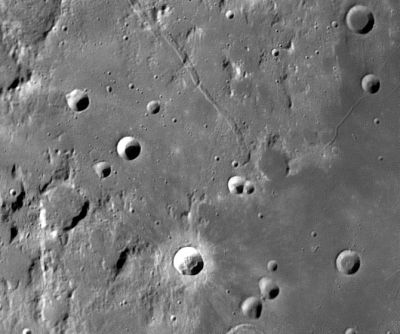Difference between revisions of "Cayley Formation"
| Line 7: | Line 7: | ||
Lat: °N, Long: °E, Diam: km, Depth: km, [[R%C3%BCkl%2034|Rükl: 34]]<br /> | Lat: °N, Long: °E, Diam: km, Depth: km, [[R%C3%BCkl%2034|Rükl: 34]]<br /> | ||
|} | |} | ||
| − | [http://www.lpod.org/coppermine/displayimage.php?pid=2166&fullsize=1 [[Image: | + | [http://www.lpod.org/coppermine/displayimage.php?pid=2166&fullsize=1 [[Image:Normal_CayleyFormation.jpg|external image normal_CayleyFormation.jpg]]]<br /> ''[http://lpod.org/coppermine/displayimage.php?pos=-2166 Mike Wirths]''; The '''Cayley Formation''' is the smooth material on the middle-left side. North to the upper right. The bright crater is [[Dionysius|Dionysius]]. The crater [[Cayley|Cayley]] (after which the formation is named) is the large circular crater to the left of center. The rille is [[Rima%20Ariadaeus|Rima Ariadaeus]].<br /> <br /> |
==Images== | ==Images== | ||
[http://www.lpod.org/coppermine/thumbnails.php?album=search&type=full&search=Cayley LPOD Photo Gallery] [http://www.lpi.usra.edu/resources/lunar_orbiter/bin/srch_nam.shtml?Cayley%7C0 Lunar Orbiter Images] [http://www.lpi.usra.edu/resources/apollo/search/feature/?feature=Cayley Apollo Images]<br /> <br /> | [http://www.lpod.org/coppermine/thumbnails.php?album=search&type=full&search=Cayley LPOD Photo Gallery] [http://www.lpi.usra.edu/resources/lunar_orbiter/bin/srch_nam.shtml?Cayley%7C0 Lunar Orbiter Images] [http://www.lpi.usra.edu/resources/apollo/search/feature/?feature=Cayley Apollo Images]<br /> <br /> | ||
Latest revision as of 01:44, 16 April 2018
Contents
[hide]Cayley Formation
(unofficial geologic name)
|
Lat: °N, Long: °E, Diam: km, Depth: km, Rükl: 34 |

Mike Wirths; The Cayley Formation is the smooth material on the middle-left side. North to the upper right. The bright crater is Dionysius. The crater Cayley (after which the formation is named) is the large circular crater to the left of center. The rille is Rima Ariadaeus.
Images
LPOD Photo Gallery Lunar Orbiter Images Apollo Images
Maps
(LAC zone 60D3) LAC map Geologic map LM map AIC map
Description
Geologic mapping of the Moon in the 1960s required every single piece of its surface to be interpreted as having a specific origin and at least a general age. The US Geologic Survey mappers recognized, apparently for the first time, that there were many relatively smooth plains on the Moon. The best known are the dark maria, but the new ones discovered by Survey mappers were light-hued. Such plains were named the Cayley Formation, after the type area surrounding the Cayley impact crater. The plains have nothing to do with the crater, it is simply the landmark they were named after. Careful observations showed that the Cayley Formation seemed to mantle earlier terrain and perhaps is on top of the hilly material that is ejecta from the Imbrium Basin. The knobby ejecta is called the Fra Mauro Formation after its type area near the crater of the same name. In the area of the crater Cayley the smooth plains are not cut by Imbrium sculpture, but the nearby Mare Tranquillitatis lavas embay (and thus are younger than) the Cayley plains. The Cayley Formation also has a higher concentration of impact craters than the mare. These observations establish a stratigraphic position for the Cayley Formation - it is younger than the Fra Mauro Formation (i.e. younger than the formation of the Imbrium Basin), but older than the emplacement of the Tranquillitatis lavas.
Survey scientists interpreted the origin as being some combination of ash flows and ashfall from an eruption cloud. This was a very reasonable view in 1965. But then we went to the Moon, and specifically to Apollo 16, which landed on an area mapped as Cayley Formation. The volcanic interpretation lasted only until astronaut John Young looked out the window of his lunar lander and noticed that the rocks were bright. Laboratory analysis showed that the Apollo 16 Cayley was all brecciated (highly fractured) impact material. Overnight the interpretation became that the Cayley all over the Moon was fluidized ejecta from Imbrium and local rocks churned up by basin secondaries. This is certainly true for the Apollo 16 area, but the German scientist Gerhard Neukum determined crater count ages of different units mapped as Cayley Formation and found they had a number of different ages, including younger than the time of formation of the Imbrium and Orientale basins. Gerhard's results don't fit our general understanding and thus they tend to be neglected. We still don't fully know what the origin or origins are for the Cayley Formation.
Additional Information
Nomenclature
Named for good exposure near the crater Cayley, but occur widely over Moon.
Is this the same formation which is called Cayley Plains on Chart 12 of the 21st Century Atlas of the Moon? - DannyCaes Aug 15, 2015
LPOD Articles
Splotches and Mounds
Flammarion X2
Bibliography
Charles A. Wood, (2006) "Looking Between Craters," Sky & Telescope, March.